VARIATIONS OF THE GROTESQUE
From the Sacred to the Profane
‘’It is no accident that the grotesque mode in art and literature tends to be prevalent in societies and eras marked by strife, radical changes or disorientation […]” (Thomson, 1972).
The source of the grotesque in art and architecture is a reflection of man’s ability to find a unique fascination in the bizarre. The psychic reasons for this tendency are far from clear, but the concept has left its mark on a variety of cultures, from prehistoric ones to the present ones, from the most primitive forms of society to the more elaborate ones. From paintings in caves to modern art and design, the transmutations of aesthetics have made their progress constantly changing with the world-views of the cultures that generated them, yet still maintaining the imperative qualities by which they can be assigned to the field of the grotesque.
CHAPTER 1 : GROTTO AND THE PSYCHE
“[…] the grotesque would affirm itself in order to better challenge and question its own nature, leading to a conception of the term which takes into account both its polymorphous and its evolutionary aspect.”(Bocianowski, 2016)
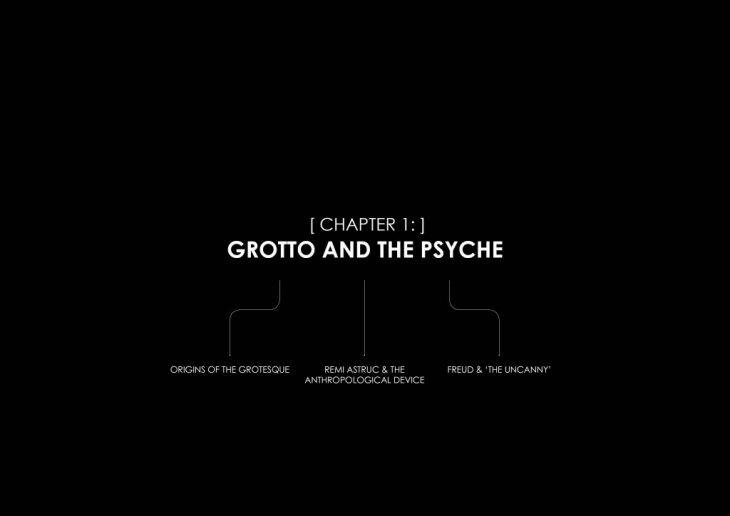
The grotesque represents a phenomenon older than history, although the term itself has a relatively recent origin, having been formulated in Renaissance Italy in order to describe a variety of unearthly decorations found in the underground rooms and corridors of Nero’s House of Gold (figure 0), which were mistakenly taken for caverns or grottos. It its most popular sense, the term designates a type of decorative and ornamental art that combines human and fantastic features, a style initially developed in Ancient Rome and imitated by a series of Renaissance artists.
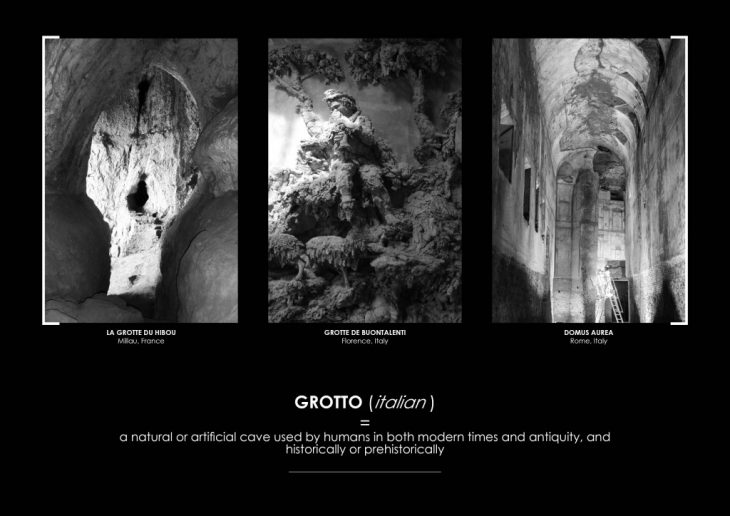
As a form constructed outside the boundaries of a fixed set of rules, the grotesque is defined by its departure from norm. Hence, it deviates from the aesthetic norms in favor of a composite artistic mode, due to its deformity and hybridity. The grotesque merges heterogeneous elements, organized according to a logic that opposes nature itself and defies the laws of both gravity and perspective.
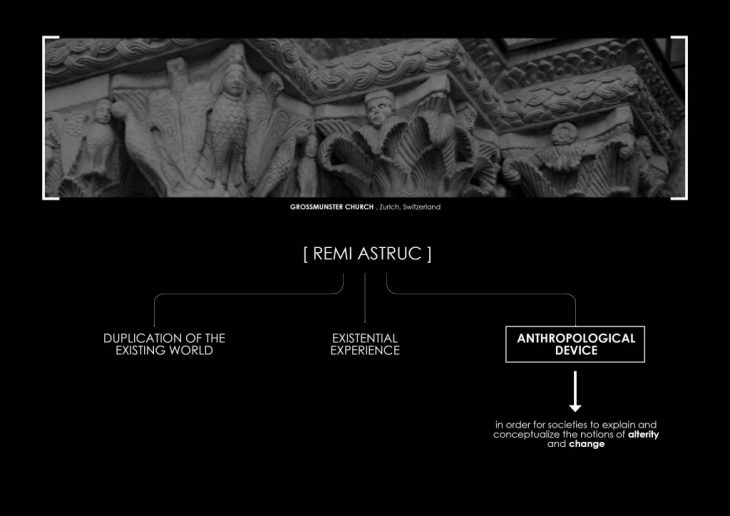
Beyond its aesthetic nature, the grotesque attains a metaphysical dimension, debated by many art critics and theoreticians. French professor and critic Remi Astruc explains that although there are a variety of motifs and figures, the grotesque duplicates the existing world by showing an altered reflection of it. He argues that the concept is based on the representation of duplication and metamorphosis. Beyond the current understanding of it as an aesthetic category, Astruc argues that the grotesque functions as a fundamental existential experience. Moreover, he identifies the grotesque as “[…] the place where the impossible finds an actual occurrence […]” (Astruc, 2010), therefore as a potentially universal and anthropological device that societies use in order to explain and conceptualize the notions of alterity and change.
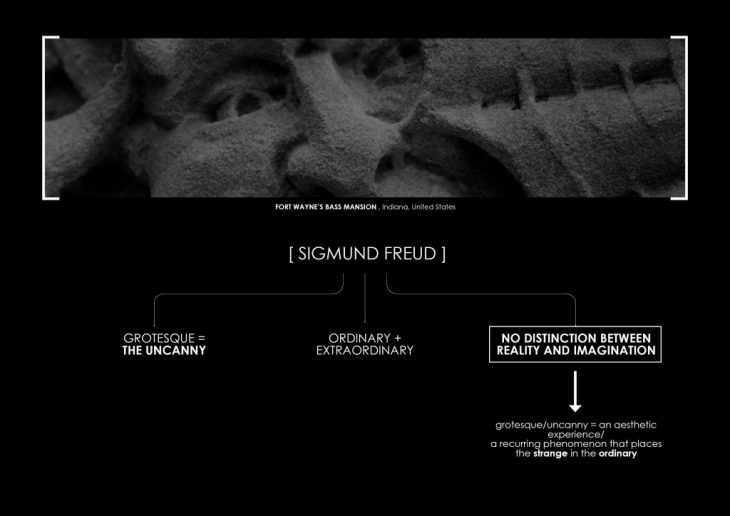
Situated in the context of the grotesque as an anthropological device, Sigmund Freud’s theory of the uncanny contours an interpretation of the grotesque as a psychological experience located between the blurred lines of ordinary and extra-ordinary. Inspired by Ernst Jentsch’s essay “On the Psychology of the Uncanny”, Freud believes the uncanny situates the strangeness in the ordinary. Hence, the uncanny effect is achieved by removing the distinctions between reality and imagination. He reinforces this theory with an example given by Jentsch: the possibility of an inanimate object to be alive, or an object that seems to be alive to be an automaton. From the outset of his investigation, Freud qualifies the uncanny as an aesthetic experience, one that can be identified as a recurring phenomenon in various mediums, including architecture.
CHAPTER 2 : ARCHITECTURAL PROGRESSIONS
“A fine grotesque is the expression, in a moment, by a series of symbols thrown together in bold and fearless connection […]” (Ruskin, 1856)
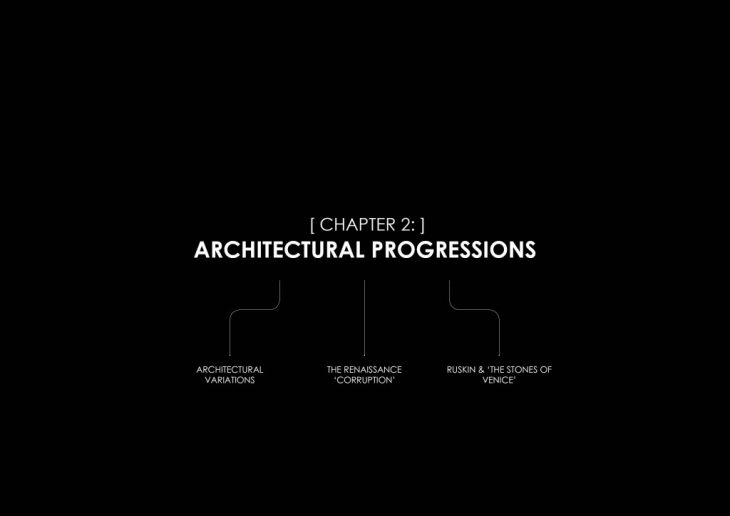
The origins of the grotesque in architecture can be traced back to primitive cultures and societal systems. The most persistent forms of the grotesque can be identified in the Greek and Roman caves –grottos – such as Apollo’s oracles at Delphi, Corinth and Clarus (figure 0). In Italy, the grottos were mainly built by exploiting and controlling the morphology of rocks and boulders, in order to create rooms with a cool climate, suitable for storing food and wine. Hence, during Antiquity, the grotesque was revealed as a method of construction, embodying mysterious rocky rooms and corridors, mainly developed for achieving functional purposes.
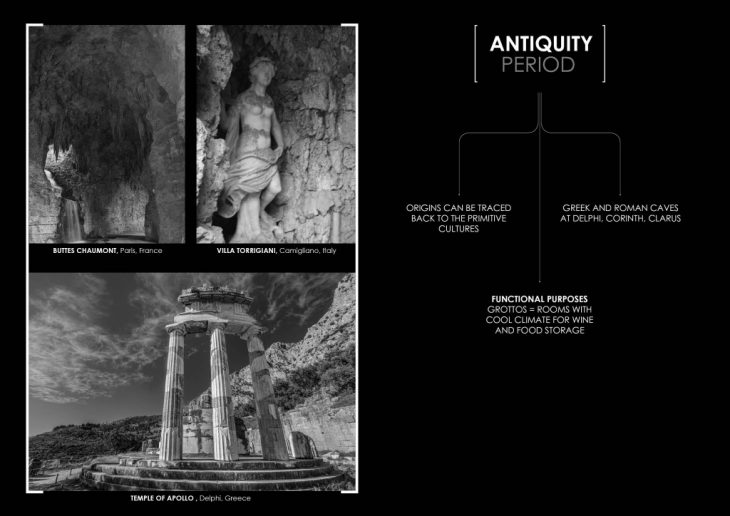
Throughout the Middle Ages, the grotesque became a tool used by the Catholic Church in order to highlight that faith will protect the people. By placing grotesque decorations representing the evil on the exterior and religious imagery representing the good in the interior areas, they conveyed the idea that one will be safe if one believed. Consequently the grotesque obtained a religious dimension, becoming a socio-cultural symbol of the mysterious, evil and destructive forces.
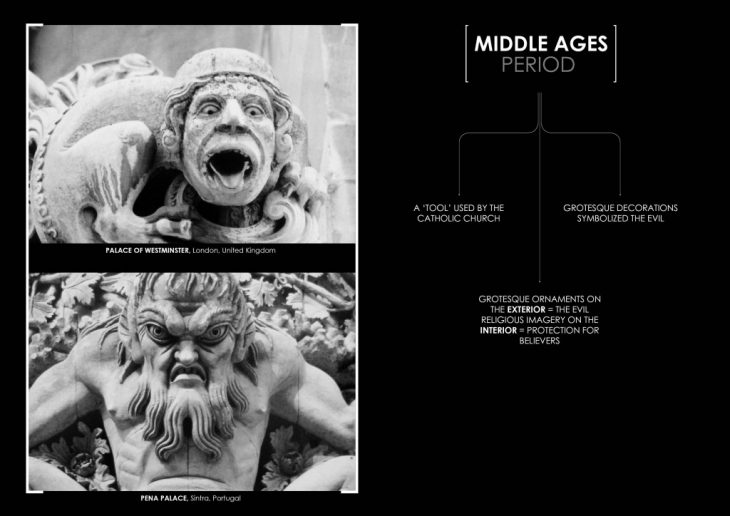
During the Renaissance period, the Gothic styles referred to the ornamental and decorative qualities of the Middle Ages. This is particularly evident in the architecture of cathedrals. The elevated architecture of pinnacles, pointed arches and flying creatures had the purpose to inspire awe, thoughts of the afterlife, the concept of divinity and even the sense of fear to the observers. Prominent examples are the intricate decorations, extreme heights, massiveness and sharp angles of the French Gothic cathedrals Rouen and Reims (figure 0, 0). Frightening creations such as gargoyles and bass-relief sculptures in niches were hallmarks for the Gothic style.
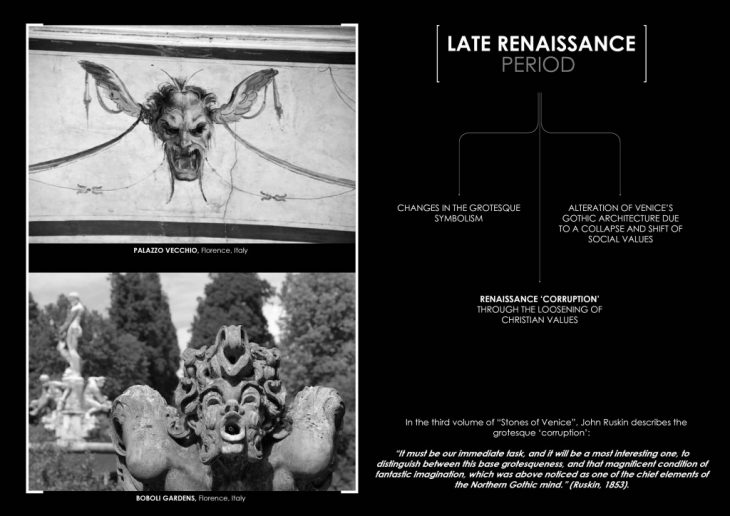
In the third volume of “Stones of Venice”, Ruskin observes a change in the grotesque symbolism. The author discusses the grotesque ‘corruption’ of the Renaissance style which reflects a wider corruption of the Christian values and the loosening of religion’s influence upon the minds and souls of the inhabitants of Venice. Moreover, Ruskin argues that the alteration of Venice’s Gothic architecture is closely linked to a collapse and shift of social values. This phenomenon is referred to as the ‘gothic renaissance’. Having already put forward the essential roles of the grotesque in Gothic architecture, he now explains and explores the difference the new grotesque and the earlier grotesque: “It must be our immediate task, and it will be a most interesting one, to distinguish between this base grotesqueness, and that magnificent condition of fantastic imagination, which was above noticed as one of the chief elements of the Northern Gothic mind.” (Ruskin, 1853). The writer identifies two base components that form the grotesque: a ludicrous one and a fearful one.
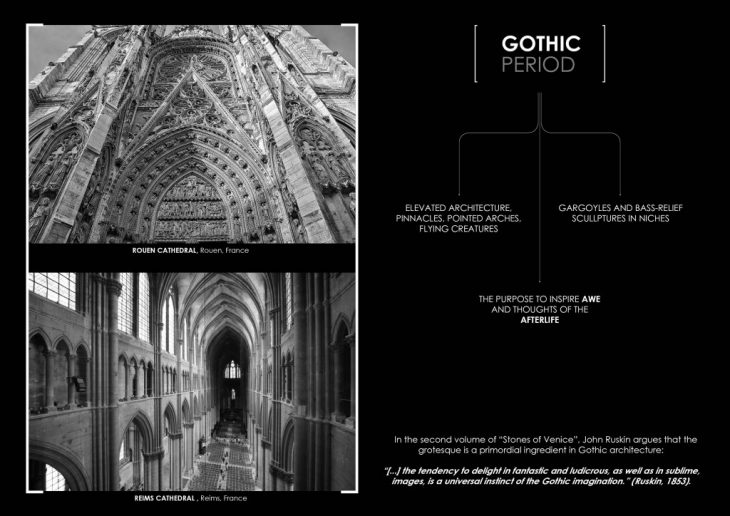
Succeeding Ruskin’s ‘gothic renaissance’, the Baroque and Victorian grotesque encompasses the field of teratology and artistic experimentation. The concept of monstrous often occurs as a playful effect, and is often depicted in ornaments based on visualizing fantastic worlds and creatures inspired by nature and old myths. It is now that the grotesque gained the denomination of ‘fantastic art’.
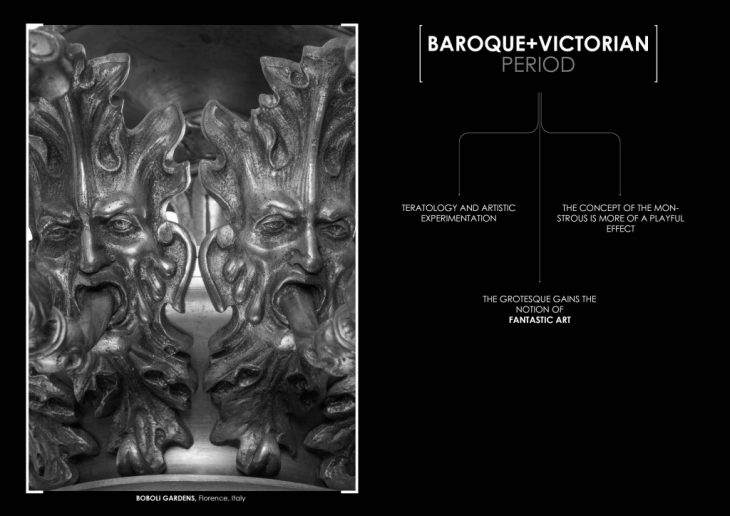
A boom in the fascination and production of arts and designs in the grotesque genre characterized the Modern period. The notion of the surreal became a recurrent motif in illustrations and decorations. In the field of architecture, the grotesque was used to express abstract ideas through materiality and volume control. The project ‘Endless House’ (figure 0) represents a conceptual architectural work by architect Frederick Kiesler, in which he seeks to express elaborate and personal metaphysics, introducing the ideas of connectivity, co-reality and bio-technique.
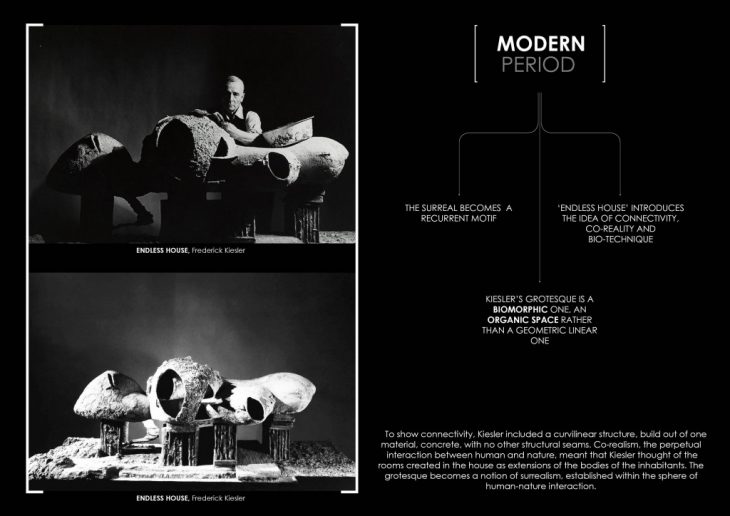
CHAPTER 3 : CYBORG-GROTESQUE
“Late twentieth-century machines have made thoroughly ambiguous the difference between natural and artificial, mind and body, self-developing and externally designed, and many other distinctions that used to apply to organisms and machines.” (Haraway, 1984)
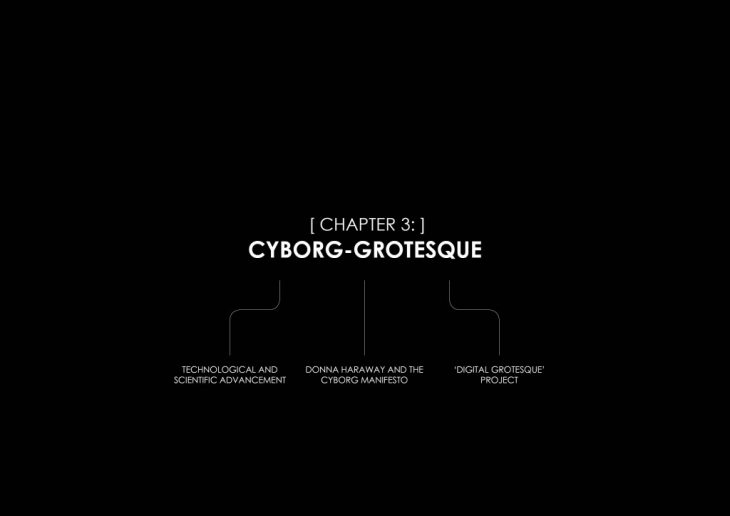
In the course of the 20th century science and technology reported a dramatic advancement. Innovative and radical developments in the physical, life and human sciences started building up the progress achieved in the 19th century. The expansion of post-Newtonian theories in physics and quantum mechanics enabled the evolution of tools and machines. New models explaining the structure of atoms lead to developments in chemistry and material engineering. Advances in biology and medicine produced an accurate understanding of genetics, DNA structures and bacterial conjugation. New knowledge has enabled people to produce innovation, making possible the evolution of human assisting technologies and scientific instruments that study both human and nature in more detail than our natural senses would allow.
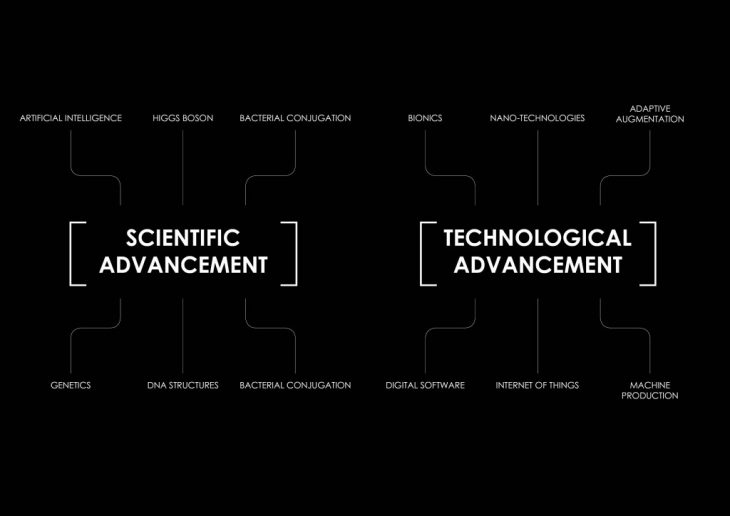
The postmodern text “A Cyborg Manifesto” by Donna Haraway embraces the advancements made in technology and science and provides the metaphor of the cyborg, as a hybrid entity: “A cyborg is a cybernetic organism, a hybrid of machine and organism, a creature of social reality as well as a creature of fiction.” (Haraway, 1984). The idea of ever-narrowing interdisciplinarity is successfully reflected in the usage of singularity, originally used to describe the moment when computer processing overtakes the capacities of the human brain, and that has now become shorthand for the way in which a fusion of technologies (bionics, nano-technologies, adaptive augmentation) converge and bring a meaningful change in the way we live and design. Haraway argues that modern production resembles a ‘cyborg colonization’ that for example in the medical field is showcased by the coupling between organism and machine, each one of them representing a coded device.
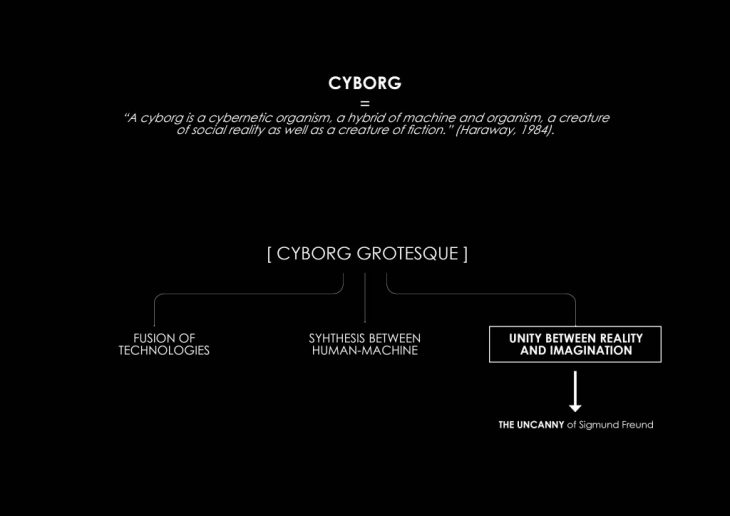
In architecture, technological evolution left its mark within the digital environment, forwarding new methods of representing and materializing space, from advanced software to augmented reality engines. ‘Digital Grotesque’ (figure 0) by Michael Hansmeyer is a project that can easily be classified as a representative of the contemporary cyborg-grotesque. The architecture consists of two installations, Grotto I and Grotto II with highly ornamental features borrowed from the Gothic grotesque but designed by algorithms. As a fictive narrative space, the project is not focused on functionality, but more on exploring the potential of digital technologies. It examines ambiguous spatial sensations and experiences enabled by advanced technologies. The authors describe the project as being situated ‘between chaos and order’, natural and artificial, foreign and familiar. The cyborg-grotesque explores unseen levels of topological complexity by developing compositional strategies based on deterministic algorithms.
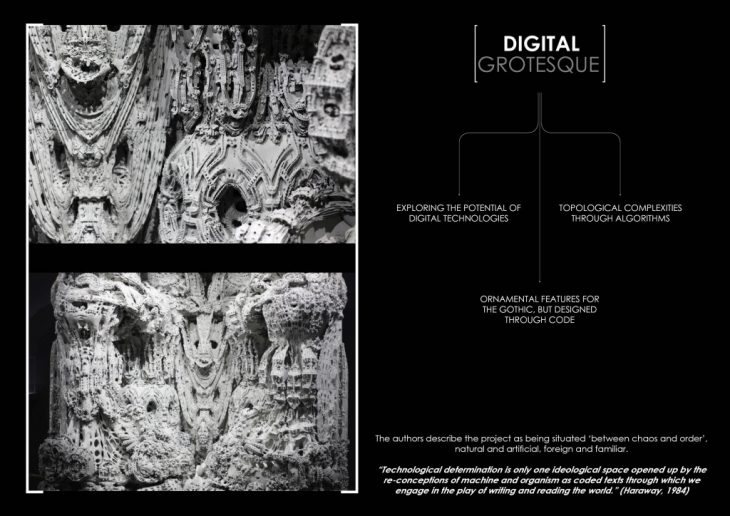
CHAPTER 4 : NEW AGE ‘MUTATIONS’
“Technological determination is only one ideological space opened up by the re-conceptions of machine and organism as coded texts through which we engage in the play of writing and reading the world.” (Haraway, 1984)
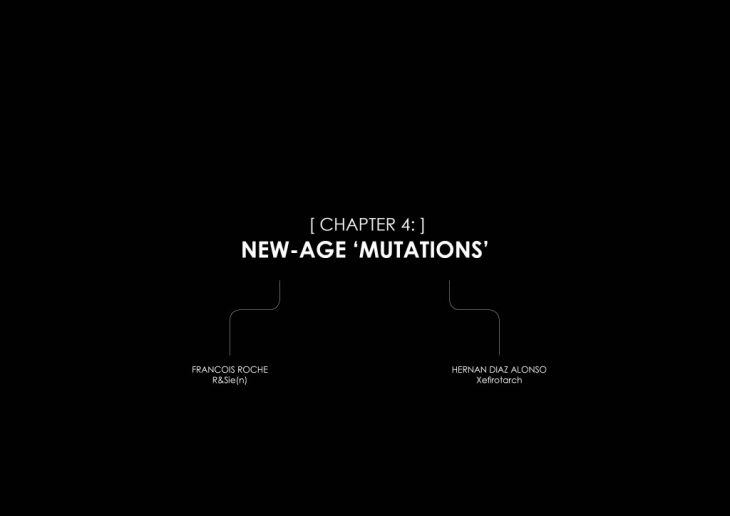
One of these branches can be identified in Francois Roche’s architectural work which puts forward a bio-operational grotesque, where nature is not only a symbol, but a protocol, an algorithm for designing. Space becomes a mathematical tool for investigating unpredictable geometries that have the ability to grow, change and morph. In both ‘Architecture des humeurs’ (2010) and ‘I’ve heard about it’ (2004) (figure 0, 0) Francois Roche makes palpable the internalized mechanisms that control the anatomical body, transforming them in dynamic and reactive modules that adapt through technology to the chemical imbalances and physiology of the inhabitants: “The human machine is crossed of a beast and an acephalic dimension, fluidity and chemistry as pre-psychic reaction.” (Roche, 2017). Roche strongly believes that architecture is no longer a modernistic programming focused on associating space with shape or function, but a link that articulates the human nostalgia, phantasms, fears and desires. In the 2015 book ‘MythomaniaS’, the French architect develops a catalogue of grotesque installations that propose what he calls ‘environmental-architectural psycho-scapes’ represented through programs for machines and bio-architectural constructs. The case studies aim to build an environment that functions as a laboratory shelter for exploring and disrupting the rift between realism and speculative fiction. This disruption constitutes the uncanny.
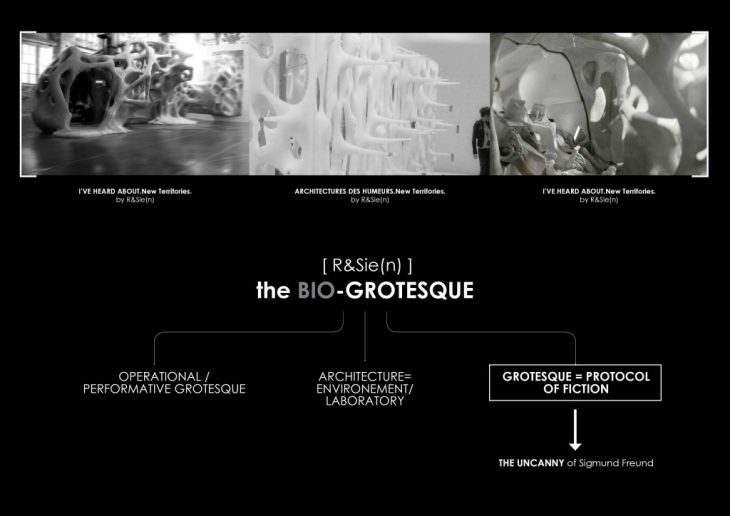
A further examination of the cyber-grotesque falls into the category of the ritualistic-grotesque, integrated in the methodology and assembly of Hernan Diaz Alonso’s spatial experiments. The architect’s design manifesto focuses on tackling the mathematical perfection brought by computational tools through a ritualistic system that creates the possibility for a ritual to become a code for the transformation of form. His work embraces a cinematic behavior, resembling more a film sequence rather than an architectural piece, starting from a singular cell and then a series of resulting transformations: “[…] certain notions of excessive and exuberance, a certain quality of formalism, and cinematic conditions that allow or enhance the possibility of the grotesque as an alternative means of theory.” (Alonso, 2013).
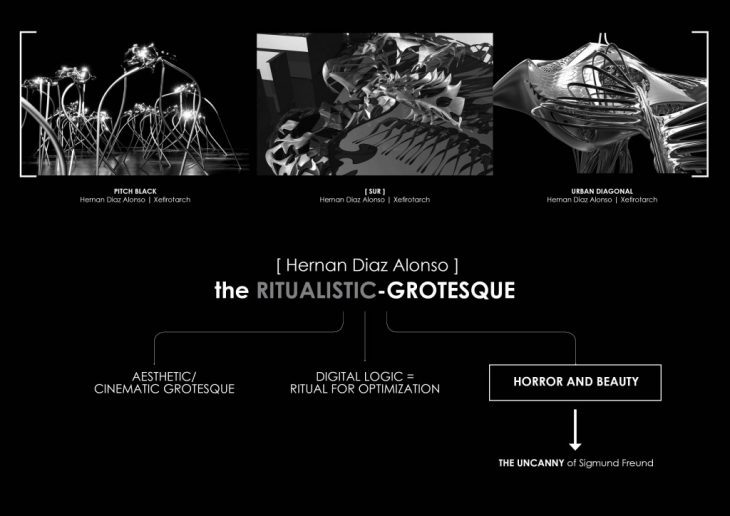
In the case of the contemporary grotesque, many branches can be explored. Whether they are more focused on visual cinematic effects or on performative operational methodologies, they both fall within the dimension of the cyborgization. The architectural entities become cybernetic organisms, predominantly situated in a digitally ephemeral realm.
CONCLUSION : FROM THE SACRED TO THE PROFANE
Throughout historical time, the grotesque has manifested itself through shape, form and decoration, embodying distinctive physical and abstract interpretations that revealed and continue to reveal the cultural views of the societies that activate them. At the outset, the grotesque represented the grotto,an ambiguous landscape-architecture exploring the sculptural aspect of natural morphologies, but also retaining a functional dimension. At this time, the grotto was not rooted in a religious-divine manifestation, but meanwhile it incorporated a sacred component that can be identified in pagan cultures.
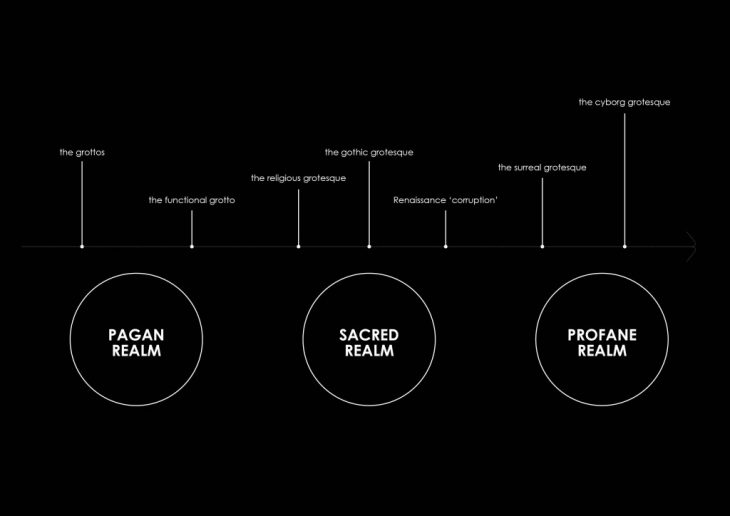
To conclude, the variations of the grotesque from primitive times to the contemporary society, have been marked by the transition from the sacred to the profane. While in the Middle Ages, religion and divinity where a guiding force in all aspects of life, including architecture, nowadays the focus has shifted towards the cyborg. The main focal point in today’s society is rooted in surpassing the immense opportunities already established by advanced technology and science. The contemporary architecture of the grotesque is concomitantly cinematic, organic, operational and surreal, overcoming the symbolic divine, and exploring new territories towards the profane.
BIBLIOGRAPHY:
Astruc, R. (2010). Le Renouveau du grotesque dans le roman du XXe siècle – Essai d’anthropologie littéraire. Paris: Classiques Garnier Numérique.
Bocianowski, C. (2015). The Genealogical Perspective in the Creation of European Literary Discourse in the Transgeneric Era. Theatre and the Grotesque.
Connelly, F. (2009). Modern art and the grotesque. Cambridge, UK: Cambridge University Press.
Cruz, M. (n.d.). The Inhabitable Flesh of Architecture.
Cruz, M. and Pike, S. (2008). Neoplasmatic design. Hoboken, N.J.: Wiley.
Delville, M. (2019). Politics and Aesthetics of Hunger and Disgust. [S.l.]: Routledge.
Freud, S. (1919). The Uncanny. Penguin Books.
Haraway, D. (1985). A Cyborg Manifesto. United Kingdom: Socialist Review
Harpham, G. (2006). On the grotesque. Aurora, Colo.: Davies Group Publishers.
Hensel, M., Menges, A. and Weinstock, M. (2010). Emergent technologies and design. Abingdon: Routledge.
Jentsch, E. and Surprenant, C. (1995). On the psychology of The uncanny (1906).
Kayser, W. (1957) .The Grotesque in art and literature. New York: Columbia University Press.
Lacadee, C. and Roche, F. (2015). MythomaniaS. New York: Punctum Books.
Lacan, J. (2018). The Four Fundamental Concepts of Psycho-Analysis. Milton: Routledge.
Lupu, M. (2013). Grotesque as Aesthetic Identity: From Medieval Illumination to Contemporary Art.
Mc Elroy B. (1989). The Grotesque and the Modern Grotesque. In: Fiction of the Modern Grotesque. Palgrave Macmillan, London
Menges, A. (2015). Material synthesis. London: Wiley.
Roche, F. (n.d.). Reclaim Resi[lience]stance.
Ruskin, J. (1906). Modern painters. London: G. Allen & Sons.
Ruskin, J. (2007). The Stones of Venice. New York: Cosimo Classics.
Semler, L. (n.d.). Early modern grotesque.
Zamperini, A. and Spring, P. (2008). Ornament and the grotesque. London: Thames & Hudson.
Variations of the Grotesque: From the Sacred to the Profane is a project developed at IaaC, Institute for Advanced Architecture of Catalonia, developed at Master in Advanced Architecture 2019/20 by:
Student: Daria Ciobanu-Enescu
Faculty: Jordi Vivaldi, Manuel Gausa